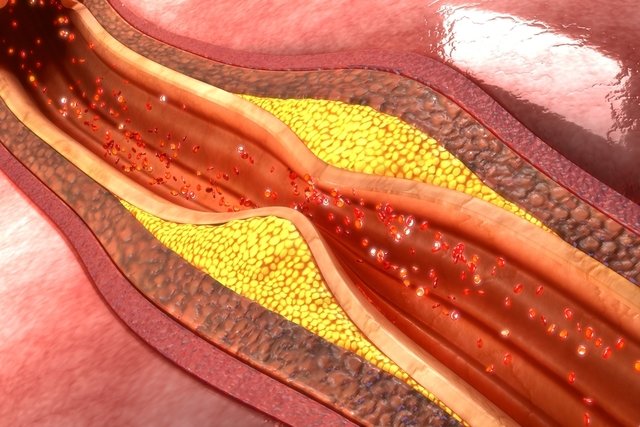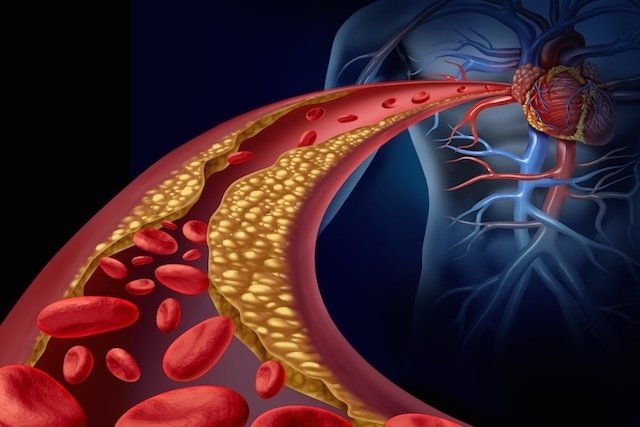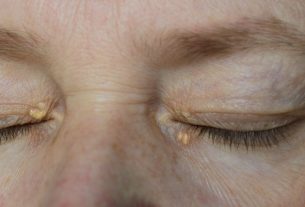Atherosclerosis is a chronic disease characterized by a major inflammatory process that occurs due to the accumulation of fatty plaques inside the vessels over the years, which ultimately results in the blockage of blood flow and favors the occurrence of complications, such as heart attack and cerebrovascular accident (CVA).
Fatty plaques can accumulate in arteries that supply the kidneys and other vital organs, which can harm the functioning of these organs. These plaques are mainly formed by bad cholesterol, LDL, and it is therefore important to maintain ideal cholesterol levels throughout life through a balanced diet low in fat and regular physical activity.

Symptoms of atherosclerosis
Atherosclerosis is a silent disease in which fat accumulates over time and, therefore, symptoms are only noticed when blood flow is severely compromised. Symptoms may vary depending on the artery that is affected, but in general they may appear:
- Pain and/or feeling of pressure in the chest;
- Difficulty breathing;
- Mental confusion;
- Dizziness;
- Weakness in the arm or leg;
- Temporary loss of vision in one eye;
- Increased blood pressure;
- Excessive tiredness;
- Signs and symptoms of kidney failure, such as strong-smelling and frothy urine, tremors and cramps, for example;
- Intense headache.
These symptoms normally appear when the artery is already completely or almost completely blocked, with a change in the supply of oxygen to the body’s organs and tissues. Therefore, as soon as symptoms indicative of atherosclerosis appear, it is important that the person goes to the hospital so that the diagnosis can be made and treatment can be started, avoiding complications.
How the diagnosis is made
The diagnosis of atherosclerosis must be made by a cardiologist initially through laboratory tests that evaluate the lipid profile, such as total cholesterol, HDL and LDL, triglycerides, CRP and apolipoprotein.
Furthermore, to confirm the diagnosis, the doctor may recommend carrying out other tests such as catheterization, cardiac tomography angiography, stress test, electrocardiogram, echocardiogram and myocardial scintigraphy, which can identify the presence of coronary artery disease, which has as one of the causes atherosclerosis.

Main causes
Atherosclerosis can occur as a consequence of different situations, and may be genetic, due to lifestyle or as a consequence of aging. The main causes of atherosclerosis are:
1. Unhealthy eating
Frequent consumption of foods rich in fat such as cakes, biscuits, industrialized or processed foods, for example, increases bad cholesterol levels in the blood, which can accumulate in the artery walls, causing atherosclerosis. The deposit of fat inside the arteries, over time, can reduce or completely block the passage of blood, which can cause stroke or heart attack.
2. Cigarettes and alcohol
Smoking can damage artery walls, making them narrower and less elastic. Additionally, smoking also decreases the blood’s ability to carry oxygen to the body, which increases the chances of a clot forming.
Excessive alcohol intake can cause hypertension and increased blood cholesterol levels, increasing the risk of developing atherosclerosis.
3. High blood pressure and diabetes
High blood pressure is also one of the causes of atherosclerosis, because when the pressure is high, the arteries have to make a greater effort to pump blood, which causes the walls of the arteries to begin to become damaged. Diabetes can also promote atherosclerosis due to excess sugar in the blood, which can damage the arteries.
4. Obesity and sedentary lifestyle
Being overweight or obese puts a person at greater risk of developing atherosclerosis, because the risk of developing high blood pressure, diabetes or high cholesterol is greater. Furthermore, a sedentary lifestyle also contributes to the appearance of atherosclerosis because fat is more easily deposited inside the arteries.
5. Heredity
If there is a family history of atherosclerosis, there is a greater risk of developing atherosclerosis, even if the person has healthy lifestyle habits. Atherosclerosis is more common in the elderly, especially males, and can affect any blood vessel, with the coronary arteries, the aorta, the cerebral arteries and the arteries of the arms and legs being the most affected.

Treatment for atherosclerosis
Treatment for atherosclerosis has as its main objective the reestablishment of blood flow, which can be achieved by removing fatty plaques from the arteries through surgery, angioplasty and/or the use of medications that must be used as advised by the cardiologist.
Medications that may be recommended by your doctor are capable of improving blood flow and, consequently, oxygen to the heart, regulating heartbeat and lowering cholesterol. It is important that treatment for atherosclerosis is carried out according to the doctor’s instructions to avoid the emergence of complications, such as heart attack, stroke and kidney failure, for example. See more about treatment for atherosclerosis.
Regardless of the treatment recommended by the doctor, it is important to change lifestyle habits, especially those related to physical activity and diet, to reduce the amount of bad cholesterol circulating and the risk of developing atherosclerosis, and it is important to avoid fatty foods as much as possible.

Sign up for our newsletter and stay up to date with exclusive news
that can transform your routine!
Warning: Undefined array key "title" in /home/storelat/public_html/wp-content/plugins/link-whisper-premium/templates/frontend/related-posts.php on line 12
Warning: Undefined array key "title_tag" in /home/storelat/public_html/wp-content/plugins/link-whisper-premium/templates/frontend/related-posts.php on line 13



